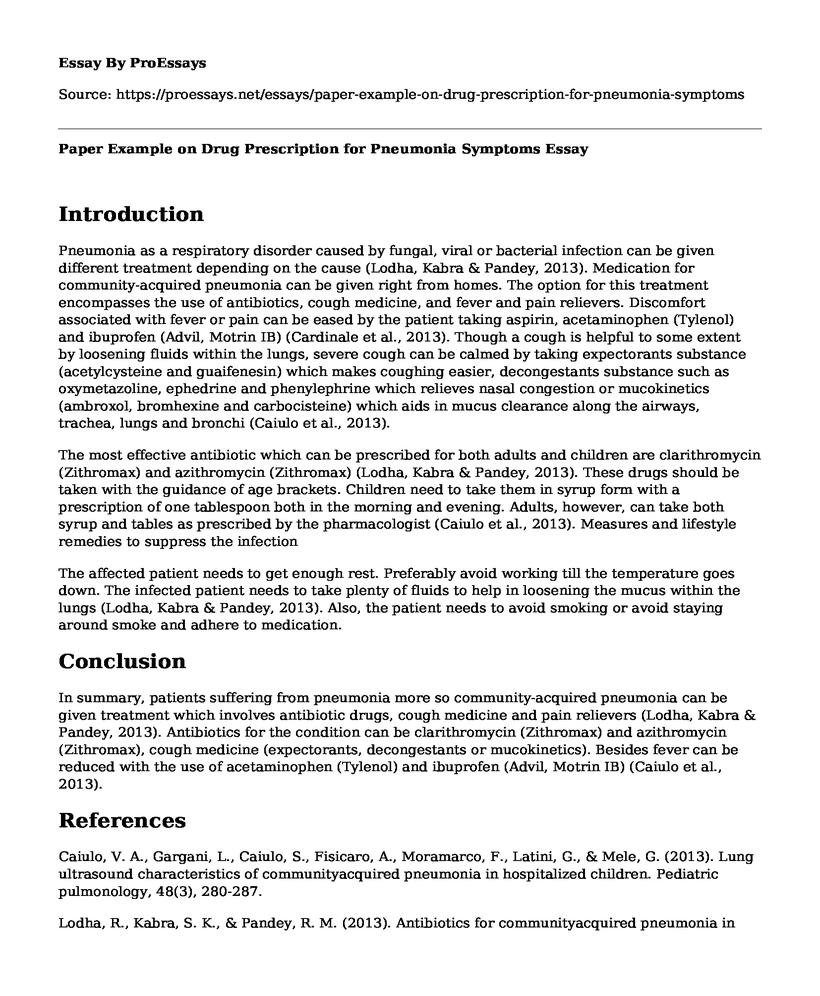Introduction
Pneumonia as a respiratory disorder caused by fungal, viral or bacterial infection can be given different treatment depending on the cause (Lodha, Kabra & Pandey, 2013). Medication for community-acquired pneumonia can be given right from homes. The option for this treatment encompasses the use of antibiotics, cough medicine, and fever and pain relievers. Discomfort associated with fever or pain can be eased by the patient taking aspirin, acetaminophen (Tylenol) and ibuprofen (Advil, Motrin IB) (Cardinale et al., 2013). Though a cough is helpful to some extent by loosening fluids within the lungs, severe cough can be calmed by taking expectorants substance (acetylcysteine and guaifenesin) which makes coughing easier, decongestants substance such as oxymetazoline, ephedrine and phenylephrine which relieves nasal congestion or mucokinetics (ambroxol, bromhexine and carbocisteine) which aids in mucus clearance along the airways, trachea, lungs and bronchi (Caiulo et al., 2013).
The most effective antibiotic which can be prescribed for both adults and children are clarithromycin (Zithromax) and azithromycin (Zithromax) (Lodha, Kabra & Pandey, 2013). These drugs should be taken with the guidance of age brackets. Children need to take them in syrup form with a prescription of one tablespoon both in the morning and evening. Adults, however, can take both syrup and tables as prescribed by the pharmacologist (Caiulo et al., 2013). Measures and lifestyle remedies to suppress the infection
The affected patient needs to get enough rest. Preferably avoid working till the temperature goes down. The infected patient needs to take plenty of fluids to help in loosening the mucus within the lungs (Lodha, Kabra & Pandey, 2013). Also, the patient needs to avoid smoking or avoid staying around smoke and adhere to medication.
Conclusion
In summary, patients suffering from pneumonia more so community-acquired pneumonia can be given treatment which involves antibiotic drugs, cough medicine and pain relievers (Lodha, Kabra & Pandey, 2013). Antibiotics for the condition can be clarithromycin (Zithromax) and azithromycin (Zithromax), cough medicine (expectorants, decongestants or mucokinetics). Besides fever can be reduced with the use of acetaminophen (Tylenol) and ibuprofen (Advil, Motrin IB) (Caiulo et al., 2013).
References
Caiulo, V. A., Gargani, L., Caiulo, S., Fisicaro, A., Moramarco, F., Latini, G., & Mele, G. (2013). Lung ultrasound characteristics of communityacquired pneumonia in hospitalized children. Pediatric pulmonology, 48(3), 280-287.
Lodha, R., Kabra, S. K., & Pandey, R. M. (2013). Antibiotics for communityacquired pneumonia in children. Cochrane Database of Systematic Reviews, (6).
Cardinale, F., Cappiello, A. R., Mastrototaro, M. F., Pignatelli, M., & Esposito, S. (2013). Community-acquired pneumonia in children. Early human development, 89, S49-S52.
Cite this page
Paper Example on Drug Prescription for Pneumonia Symptoms. (2022, Aug 10). Retrieved from https://proessays.net/essays/paper-example-on-drug-prescription-for-pneumonia-symptoms
If you are the original author of this essay and no longer wish to have it published on the ProEssays website, please click below to request its removal:
- Nursing Organizations Essay Example
- Paper Example on Maternal and Fetal Death after Dengue Infection: Insights on Dengue Diagnosis
- Essay Sample on Patient Education
- High School Graduation Rate: Impact of School Social Workers - Essay Sample
- Research Paper on Malnutrition: Devastating Effects from Birth to Adulthood
- Research Paper on Family Health: Analyzing Social Determinants for Optimal Outcomes
- Paper Example on COPD: Symptoms, Diagnosis, and Treatment







